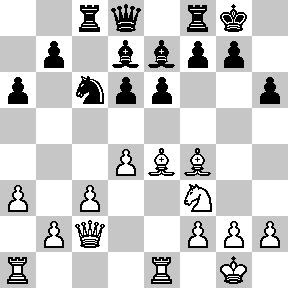Chess Openings: Part 2
The trouble is, it's really hard to know what the best way to study an opening is. What are you trying to learn, and how will the lessons take root? For example, assuming that we can agree that ideas, tactical motifs, and positional patterns for strengths and weakness are more important in one's knowledge of an opening system than concrete lines, what happens if we misapply something? It's easy enough to read through a few variations, get an idea, and then try to generalize. Here are some praxis examples:
White: Joshua Haunstrup (1825)
Black: William Michael (1730)
Event: MCC Fall Swiss (4)
Date: 2006-09-26
(B45 Sicilian, Taimanov V)
1 e4 c5
2 Nc3 e6
3 Nge2 Nc6
4 d4 cxd4
5 Nxd4 Nge7?
Poor William was trying to play Taimanov's system in the style of Taimanov himself I'm sure. Grandmaster Mark Taimanov pioneered the whole modern interpretation of the Paulsen Sicilian complex, but then went off on an eccentric and very interesting tangent with lines that include Nge7. Most of these lines are theoretically considered a little suspect, but they are very creative and different for the Sicilian, and several opening books expound the virtues of them. HOWEVER, even when playing Taimanov's own pet lines, there are some basic rules for development in the Paulsen complex, and playing this move on move 5 is an absolute no-no. What followed was:
6 Ndb5

6... d5?
This loses quickly, but even after the necessary 6...Ng6, William would have been forced to give up his dark-squared bishop after 7.Nd6+, and would then have been saddled with an inferior game with weak dark squares and an ugly and unpleasant defensive task.
7 exd5 exd5
8 Bf4 Ng6
9 Nc7+ Kd7
10 Qxd5+ Ke7
11 Qc5+ Kf6
12 Qg5++ 1-0
Afterwards, he told me he was sorry that he didn't give me much of a game. Sure, there were some tactics involved, but it's really hard to spy complex tactics from the getgo. At the beginning of a game, the heuristics of patterns are supreme. They tell us how to play a position, what to anticipate, what to be afraid of, what to strive for.
Here's a subtler example:
White: Christopher W. Chase (2316)
Black: Joshua Haunstrup (1826)
Event: MCC Stanley Crowe Memorial (4)
Date: 2006-10-24
(A08 Réti, King's Indian A)
1 e4 c5
2 d3 e6
3 Nf3 Nc6
4 g3 d5
5 Nbd2 Bd6
6 Bg2 Nge7
7 0-0 0-0
8 Nh4

Alright, so I knew that Chris played the King's Indian Attack, and I knew some variations of the opening pretty well, as my father always played it, but I didn't recall what black was supposed to do here. More generally, I think that I lacked a sense of the positional themes of the opening. I knew some moves, and after that, I would adopt a wait and see attitude, doing my best to parry the kingside attack. There's more to an opening than that though. You have to put your pieces on coordinated squares and then know how to use them once they get there.
8... b6?!
This move does all of nothing, but it looks alright, I mean it's a move that black does make in other variations...
9 f4 dxe4
10 dxe4 e5
11 c3 Ba6
12 Rf2 Qd7
13 Nf5

And here it's panic time. Chris has some nasty threats, my position looks about as rock solid as swiss cheese, and I don't have the foggiest idea what I'm doing. Have I blundered? Not really, although yes, in a sense. My game is coming close to indefensible and I haven't even started playing, all because I don't know the opening.
13... Nxf5
14 exf5 exf4
15 Ne4
And here I should have just resigned.
Now, did I learn from this fiasco you ask? No, not at all. I simply made a mental note that f5 could be a problem square in the King's Indian Attack, and I stored that memory for a future date. Ahem.
White: Max Enkin (2249)
Black: Joshua Haunstrup (1877)
Event: Harry Nelson Pillsbury Memorial (1)
Date: 2006-12-02
(A08 Réti, King's Indian A)
1 e4 c5
2 Nf3 e6
3 d3 Nc6
4 g3 d5
5 Nbd2 Bd6
6 Bg2 Nge7
7 0-0 0-0
8 Nh4

Here we go again. Another master, the same position, time to show that I learned.
8... f5!?
Ahhh, much better, at least it's a playable move!
9 f4
And now what? IM John Watson gives 9...b5, but that's not the sort of move that you would innocently think up by yourself. No, I played what seemed logical again, and was out of my depths in no time:
9... dxe4?!
10 dxe4 Bc7?!
Whoops, this can't be right. What about the gaping hole on e5? That looks like a positional disaster, but at least he's not going to kill me on f5, right?
11 c3 e5?!

Problem solved... ha! The end draws near.
12 fxe5 Bxe5
13 Nxf5 Nxf5
14 exf5
And, up a pawn and with freer pieces, Max finished me off easily.
These kinds of opening disasters are common place in class competition, and they really do underscore the need for concrete knowledge. It's not about knowing specific moves, it's about having a sense of where your pieces need to be and what you need to be afraid of.




















